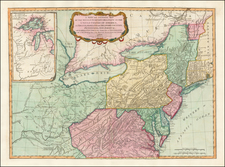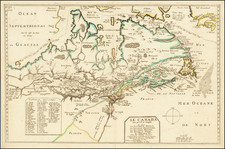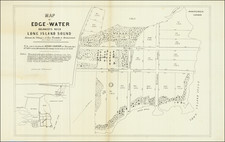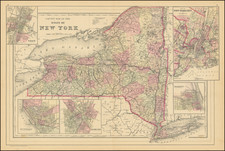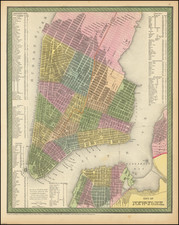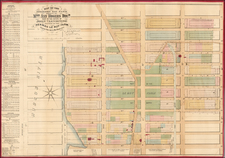A scarce and historically important sea chart of the Harbor of New York City and Environs, made immediately in the wake of the American Revolution, printed by the firm of Mount & Page.
This detailed and finely engraved chart embraces all of New York Harbor, from Sandy Hook Bay to Manhattan, and is centered on Staten Island and the Narrows. Importantly, it represents one of the earliest accurate charts of New York Harbor and the first post-Revolutionary War update for the harbor. The delineation of the shorelines and major headlines is remarkably accurate and the seas contain numerous hydrographic soundings, based on recent surveys.
The story behind the creation of the chart is most interesting. In September 1776, the British launched the largest amphibious military operation ever seen in the history of North America, in an effort to seize New York City from Washington's American Army. While the British succeeded in this objective (New York City remained the British Headquarters for the remainder of the Revolutionary War), Lord Admiral Richard Howe, the Commander of the Royal Navy in North America, was alarmed by the lack of accurate hydrographic information relating to New York Harbor. The best available chart of the area was Mark Tiddeman's chart of 1732, a work which could at best be described as archaic, if not frightfully inaccurate. Howe was deeply concerned for the safety of his ships, especially as local pilots were in short supply.
Fortunately, aboard Howe's flagship, the HMS Eagle, were two of the most talented coastal surveyors in British service, Lieutenants John Hunter and John Knight. John Hunter (1727-1821) was a seasoned mariner and surveyor having made numerous charts of various locations in Europe and the West Indies. In 1770, he ingeniously rescued his vessel, the HMS Carysfort, which was lodged dangerously upon a reef off of the Florida Keys, a feat which brought him much acclaim. In addition to his mapping of New York Harbor, Hunter conducted a masterly survey of the Delaware River, following the British invasion of Philadelphia in 1777. However, he is today most famous for his adventures in Australia. In 1788, he became the first to correctly surmise that Tasmania was an island, and from 1795 to 1800, he served as the second Governor of New South Wales.
In the years leading up to the war, John Knight (1747-1831), as master of the HMS Diligent, had assisted J.F.W. Des Barres and Samuel Holland on their groundbreaking surveys of New England and the Canadian Maritimes. Knight later served in the sea war against Napoleon Bonaparte. In 1800, he was given the task of surveying the entrance to the key French naval base at Brest, which caused Admiral Sir John Jervis, Earl St. Vincent, to pronounce him "to be the most accurate [surveyor] in His Majesty's service". Knight eventually attained the rank of full Admiral.
Howe ordered Hunter and Knight to conduct an advanced charting of both New York's inner and outer harbors, based on triangulated surveys predicated on astronomical observations. This was done with great dispatch, and Hunter & Knight's chart was completed by the end of 1776, with manuscript copies given to Howe and others sent home to the Admiralty. In London, a copy was given to J.F.W. Des Barres, who was in the process of printing sea charts of America as part of the Atlantic Neptune (1775-84), a grand sea atlas intended for use by the Royal Navy. Des Barres was the first to print Hunter & Knight's survey as A Chart of New York Harbour (1779).
While Des Barres' chart was a work of great beauty and precision, it was exceedingly large, expensive, and hard to acquire (few copies were printed). In the years immediately following the war, the London chartmaking firm of Mount & Page, which held the rights to issuing the longest-published sea atlas of American waters, The English Pilot, Fourth Book (first issued in 1689), decided to create a new chart of New York Harbor. The chart was to appear in the final three additions of this atlas, issued between 1783 and 1794. As noted by Seller & Van Ee:
Competition from The Atlantic Neptune and an increased demand for accurate surveys of the American coast forced the publishers of The English Pilot to update several charts in their atlas. This improved chart of New York Harbor shows many new shoals, channels, soundings, navigational sightings, and landmarks...
As shown by the present example, the chart appears in convenient folio form and its clear and precise design makes it easier to read aboard ship than Des Barres' elaborate predecessor. While generally based on Knight and Hunter's surveys, it includes a few new details gained since 1776. Affordable and convenient, Mount & Page's chart soon became the most popular chart of New York Harbor used by mariners from both Britain and America and was widely copied.
The present chart is now scarce in the market. We note no examples in dealer's catalogues for more than 10 years.









